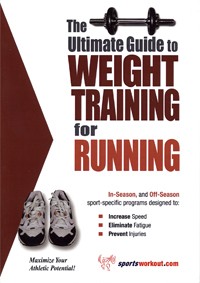Ultimate Guide to Weight Training for Running
|

|
| Author: |
Price R |
| Category: |
Strength Training |
| Audience: |
Consumer |
| Length: |
64 pages |
| Publisher: |
Price World Enterprises |
| Year Published: |
2003 |
| List Price: |
$19.00 |
|
|
|
|
AthleteInMe.com®
Rating:
 Poor
Poor
The Ultimate Guide to Weight Training for Running is one of at least 30 books by the same publisher offering sports-specific weight training. Unfortunately, this book ("booklet" would be a more accurate label!) is anything but an "ultimate" guide, since it leaves a lot to be desired.
ABOUT THE AUTHOR
The author is Robert Price. His credentials are listed as "CPFT", which, according to the National Board for Respiratory Care (www.NBRC.org) stands for "certified pulmonary function technologist". The back cover describes Price as a bench press and power lifting champion and a "First Class NFPT Certified Personal Trainer". NFPT stands for National Federation of Professional Trainers (www.NFPT.com).
CONTENT
PART I: Year Round Program
- Introduction
- Off-season program
- In-season program
PART II: Getting Started
- Warming up
- Cooling down
- Abs
- Stretching
- Proper Form
- Proper Breathing
PART III: Recommended Exercises
- Substituting similar exercises
- Chest exercises
- Back (lats) exercises
- Shoulders exercises
- Triceps exercises
- Biceps/forearms exercises
- Legs exercises
PART IV: The Necessities
- Perfecting your technique
- Estimating your one-rep max
- The different folks, different strokes principle
- Overtraining and staleness
- The declaration of variation
- Muscle fibers
- Training techniques
- When to increase
- Safety reminders
- Record Keeping
- Test yourself
- Conclusion
REVIEW
One should not be misled by the length of this list; the entire book is only 60 pages long. In fact, it can be read completely in about 30 minutes.
The main problem I have with this book is that it doesn't live up to its title: It doesn't really emphasize exercises for runners. Instead, The Ultimate Guide is essentially a general overview of weight-lifting. For example, the exercise programs on pages xi - xiv list more arm exercises than leg exercises. Leg exercises that are listed include leg press, squat, lunge, etc., but nowhere in the book is hip abduction or hip adduction mentioned. Exercises to strengthen the hip flexors -- an important leg exercise for runners -- is also omitted.
I wouldn't call this book a weight "training" guide either. "Training" implies -- at least, to me -- that there is a specific goal. The book does not offer either event-specific, or goal-specific training programs. For example, there is no distinction between exercise programs for distance runners vs. sprinters. Circuit-training is mentioned only briefly, and there is no discussion of the concept of "periodization" as it pertains to weight-training.
The photos which illustrate the various exercises are good, but, again, arm exercises are emphasized over leg exercises. Why does a runner needs to do "behind the back wrist curls"? Ironically, there are no photos for the seated calf raises and the reverse calf raises.
The section on stretching is decent, but the hip flexors are also ignored here. The section on stretches for the calf muscles needs to clarify that straight-leg stretches (keeping the heel on the floor) stretches the gastrocnemius while the same stretch with a bent knee stretches the deeper soleus muscle. Calf stretches are one of the most important stretches for runners.
Finally, the editing of this book is poor. Sophisticated concepts such as 1-RM, concentric exercise, and eccentric exercise are mentioned before they have been adequately defined or explained. Part IV seems completely out of place. I wondered if this book was simply boiler-plate content, repackaged over and over. Indeed, on page viii it states: "...you must continue to swing the racquet consistently throughout the off-season to help keep your body loose and ready to play the next season." Is this just a metaphor, or was this statement accidentally left in from one of the other books in this series?
SUMMARY
In summary, if you can ignore the sloppy editing and accept that the book isn't really geared for runners, there is actually some good information here. But, the title needs to better represent what the book really is, perhaps something like "Weight-Lifting: The Basics". Considering that this book is only 64 pages long, yet costs $19.00, I cannot recommend this book.
Copyright ©2005 AthleteInMe, LLC. All rights reserved.
| Reviewed by: Stan Reents, PharmD |
4/5/2017 8:14:18 AM |
|